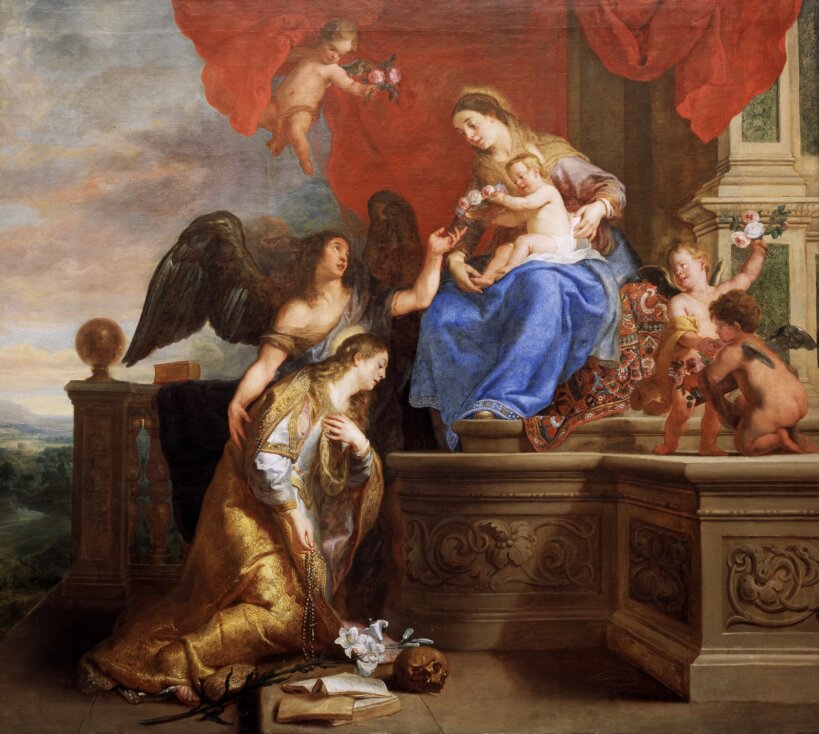The Museum of Fine Arts Ghent (MSK) lent three paintings and a selection of drawings by painter Gaspar de Crayer (1584-1669) to the Musée de Flandre in Cassel (FR) in 2018. There, they were part of the retrospective exhibition 'Between Rubens and Van Dyck. Gaspar de Crayer, a court painter' (30 June - 4 November 2018), which zoomed in on the work of this unjustly forgotten master of Baroque art. For centuries, De Crayer was mentioned in the same breath as grandmasters Rubens and Van Dyck.
The MSK took this opportunity to put the painter himself in the spotlight, and to highlight his close connection with Ghent. The MSK's Forum hosted the collection presentation 'Inextricably linked. Gaspar de Crayer and Ghent' featured some works that were too large to travel to Cassel. At the same time, the presentation is an invitation to travel into the city. After all, you can still find works by De Crayer in several Ghent churches.
Between Rubens and Van Dyck
Born in Antwerp in 1584, Gaspar de Crayer grew up in an artistic world marked out by the trio Peter Paul Rubens, Jacob Jordaens and Anthony van Dyck. But he is no slavish follower of these masters. His talent as a portraitist, as a painter of large religious pieces and his sense of composition made him famous, and until the 20th century he was often mentioned in the same breath as Rubens and Van Dyck as one of the great Baroque painters.
De Crayer in Brussels and Ghent
De Crayer does not stay in Antwerp. He probably moves to Brussels, where he is apprenticed to Raphael Coxie (c. 1540-1616), son of the better-known Michiel Coxie. Brussels was at that time the residence of Archdukes Albrecht and Isabella and the country's elite, and the artist diligently painted portraits of these prominent inhabitants. From 1635, he became court painter to the Spanish governors.
Gradually, De Crayer became best known for his impressive religious compositions. He was asked all over the country to create altarpieces and other devotional paintings. And very early in his career, he receives commissions from Ghent. His work ends up in churches, monasteries and the town hall there. After the French Revolution, several of these works were included in the collection of what would eventually become the MSK, but even today De Crayers still hang in, for instance, St James' Church, St Bavo's Cathedral, St Peter's Church and the city hall.
In 1664, De Crayer also settled with his wife in Ghent. Although he was then already very elderly, he continued to work for his Ghent religious clients. He continues to live in Ghent until his death in 1669, and is buried in the now-defunct Dominican Church with a 'Resurrection of Christ' by his own hand above his tomb.
A room full of De Crayer
The collection presentation 'Inextricably linked. De Crayer and Ghent' showed a selection of De Crayer's oeuvre, in the large central hall (the so-called forum) of the MSK. It was an excellent opportunity to draw attention to this lesser-known topper from the Ghent collection, and to highlight his connection with Ghent.
Among the works on display, there are the impressive formats with monumental touches, such as The Judgement of Solomon (c. 1620-1622, made for the courtroom in the Castle of the Counts), and delicate creations such as Mary with Child adored by various saints (made for the church of the Great Beguinage Sint-Elisabeth) and The Coronation of Saint Rosalia (made for the Jesuit Church in Ypres). In turn, Crayer's fame as a portraitist is evident in the stately Portrait of Bishop Antonius Triest, Ghent's greatest art patron.
